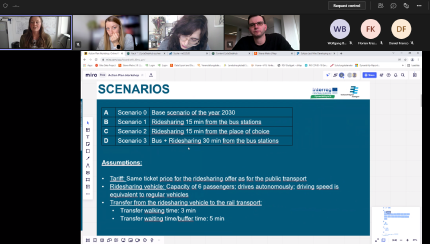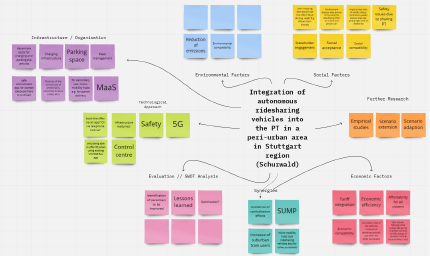Dynaxibility4CE discussed next steps of the Stuttgart Schurwald scenario
The scenario focused on the implementation guidelines on how to integrate autonomous ridesharing-shuttles into the public transport in a peri-urban area in the region of Stuttgart.
The Schurwald area, which is located East of Stuttgart, is not a remote forest as the name suggests, but a peri-urban area at the outskirts of the sixth largest German city. This area was subject to a transport model study that simulated the transport solutions of the future, including electric and autonomous shuttles. The study, which was already prominently featured by ‘Verband Region Stuttgart’ (VRS) during the ITS World Congress and the POLIS Conference 2021, was subject to internal discussions about the potential implementation impacts and possible further research with a group of severalDynaxibility4CE colleagues.

Nadine Müller presents different modelling scenarios for the Schurwald area.
An analysis of the Schurwald, a district that is home to around 50.000 inhabitants, who can access 25 different bus lines, was executed in cooperation between VRS and University of Stuttgart. VRS has a significant interest in potential future public transport solutions to guarantee a proper service across every area of Stuttgart. A transport model that was created in 2009/10 with the transport planning software PTV Vissum was laying the grounds for this study on DRT solutions.
What are the challenges of the scenario?
In order to properly imitate the future impact of (autonomous) ride-sharing shuttles in the year 2030, bold parameters were chosen by the researchers, as they assumed that the autonomous shuttles for six passengers can operate with the same speed as bus- or car drivers. Frieder Oesterle, EU Coordinator, elaborated:
‘we are expecting a significant leap forward for the autonomous driving technology and infrastructure investments are always long-term. Thus, we need to assume such a drastic performance increase to calculate the maximum impact of autonomous vehicle technology’.
Besides the baseline assumption for 2030 without any introduction of demand-responsive transport, two scenarios focused on the introduction of ride-sharing solutions, which either stop at the regular bus stops or pick up users from their place of choice. In a third scenario these ride-sharing solutions are combined with three certain regular bus lines. The two ride-sharing solutions would require significant investments in more than 350 of such 6-seater vehicles and would drive around 20% of the time empty. In the third scenario the number of overall vehicles, empty kilometers and overall kilometers driven would significantly drop.
Whether or not the DRT and bus solutions for public transport are autonomous or not, the ride-sharing- solutions are roughly three times more expensive than the baseline bus system. Furthermore, the assumption that emissions would significantly drop in comparison to the existing bus scenario is also not correct, as emissions would remain similar as more ride-sharing vehicles would be on the road.
Even if all vehicles would be electric, the ride-sharing solutions would emit more greenhouse gases than an electrified baseline bus service. The reason is mainly that the CO2 emissions of the production chain is integrated into the calculations. Emissions calculations for the prospective electric vehicles aren’t zero, since the German energy mix still has a significant share of electricity generated by non-renewable energy sources.

So, are these scenarios a complete failure? No, they are not.
They highly improve the transport offer in a peri-urban area and the ride-sharing would increase the occupancy rate per vehicle from 1.3 persons per vehicle (passenger car) to 2. Moreover, the modal split changes in all three scenarios towards an increase of public transport and decrease of motorized individual transport. In addition, trips by private passenger vehicles are substituted by the DRT system, but the ride-sharing vehicles increase the total driven distance, leading to more traffic on the streets. Since trips would only take marginally longer with the ride-sharing system (between 1.5 and 3min), the new solution should be extremely successful. Nevertheless, the assumption that autonomous vehicles are as fast as normal vehicles operated by humans is rather optimistic. These assumptive calculations are necessary to have a scenario that provide a viable alternative for currently existing transport solutions.
In order to further consider and refine these scenarios, which currently only exist in a digital software model, VRS asked the Dynaxibility4CE partners to think further about the integration of autonomous ridesharing into the public transport system of Stuttgart region. Topics, such as the technological aspect or the infrastructure investments of the new system were discussed. How can senior citizens book the DRT system without an app? What safety features are necessary and what transmission technology, such as 5G, would be necessary in this peri-urban area? Furthermore, questions were raised concerning the necessary parking space at popular destinations, such as multimodal hubs? How could the charging infrastructure be organised to reduce overall vehicle downtime and guarantee operability?
‘These topics were great food for thought for us and we are discussing them internally to determine our direction of research’, emphasised Nadine Müller, regional transport planner, from VRS.
